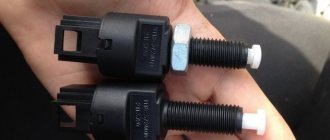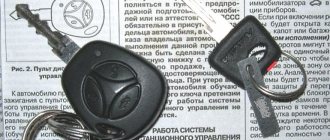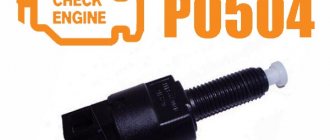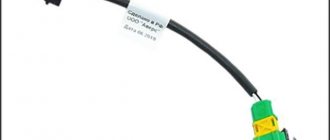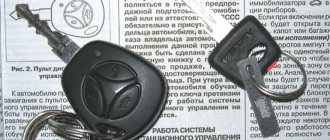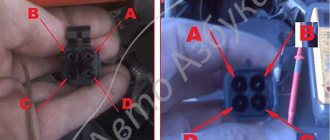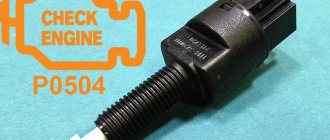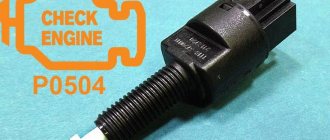The Kalina brake pedal sensor is a technical device that is used to monitor the degree of impact on the brake pedal. Quite often, car owners of the VAZ line complain about breakdowns or incorrect adjustment settings of the product.
Fortunately, the process of adjusting or replacing a part is not very difficult if certain nuances are observed.
Description of the brake pedal sensor
Below we will find out how it works and how to replace it.
Purpose, location and operating principle
The essence of the system is that when you press on the brake, the piston in the cylinder begins to move. After this manipulation, fluid enters the brake system from the intake valve. It passes through the pipelines towards the main wheel mechanism, thus creating a suitable situation for the pads to move towards the wheel discs and drums. As a result, contact and subsequent braking occur. The controller itself turns on the brake lights.
Brake end piece
Typical malfunctions and methods for their elimination
When “communicating” with a car, you can encounter various problems, but there is the most common and annoying problem. This problem is called error P0504, or otherwise “Brake pedal sensor mismatch.”
This malfunction often slows down the car. To solve this issue, you need to release the brake pedal and adjust the gap in the position sensor.
The adjustment is quite simple:
- It is necessary to hang a small but weighty weight in the area of the rubber brake pad.
- Unscrew the sensor nut a little and bring the white part to the brake pedal so that there is a gap of 0.2-0.5 mm between the body thread and the white tip. The sensor must be fixed in this position.
New replacement part
How to change
The sensor is located slightly above the brake pedal lever. To find it, you need to look under the torpedo. On Lada Priora, Grant and Kalina, a 19 mm open-end wrench will be required for dismantling. The replacement process looks like this:
- Remove the negative terminal from the battery
- Disconnect the 2 plugs from the sensor.
- Loosen the locknut with a 19 mm wrench (remember its approximate location).
- Unscrew the sensor counterclockwise.
- Install a new one and secure it with the adjusting nut.
- Connect the battery.
- Turn on the diagnostic equipment and clear the old error P0504.
The old sensor is quite repairable. In most cases, the cause of the malfunction is a broken spring. If you disassemble the body and install a new spring, the “frog” will work again.
Car owner's comment: On my Lada Grant, a spring broke in the sensor and began to close the contacts of the limit switches. When I left the car overnight, the ignition did not seem to turn off, which is why the battery ran out completely several times. I bought a new battery, but the problem did not go away until I made diagnostics and replaced the sensor. At the same time, the Check Engine did not light up.
Instructions for replacing the brake controller
- Pump out the liquid.
- Place the vehicle on a support stand and remove the wheel.
- Use a wrench to unscrew the two wheel pins.
- Remove the brake drum.
- Then, using a screwdriver, pull out the hook of the upper tension spring and remove the part. Perform the same manipulation with the lower tension spring.
- Then remove the front pad and spacer bar, while disconnecting the pressure spring and lower the pad.
- Remove the shoe lever from the parking brake hole, straighten the cotter pin and remove it from the parking brake drive.
- Remove the washer and lever.
- Install a new block and assemble the part in the reverse order.
Rear disc brakes on Lada Kalina
How to replace the sensor?
If you have received error code 0504, to perform this simple procedure you will need to provide access to the pedal bracket on the Lada Granta, on which our “ill-fated” sensor is actually present, or rather, above the pedal assembly. A well-carried out replacement will guarantee long-term operation.
- Remove the negative terminal from the battery terminal.
- We press out the plastic retainer (use a screwdriver).
- Next, remove the block with wires.
- Turn the sensor in a clockwise direction.
- We remove the faulty part.
We install the new component on a Lada Granta car in the reverse order. Don’t forget to first release the pedal to be able to insert the new product into its socket. We turn the component against the direction of the arrow until the corresponding click appears.
Source
Description of the clutch pedal sensor
What kind of device is this and how to replace it is below.
Purpose, location and operating principle
The clutch sensor is installed directly on the clutch pedal. It influences engine control with an electronic gas pedal and provides a convenient and flexible control scheme for machine modes. On its own, it looks like a nondescript switch that has on and off modes.
Typical malfunctions and methods for their elimination
If the controller does not detect signals from the clutch, then there is a risk of error 0830. The occurrence of this problem is usually a malfunction of the clutch sensor or a short circuit or open circuit. To correct this state of affairs, it is necessary to identify the reasons. That is, inspect the contacts for breaks or corrosion.
Reasons for error p0504
The appearance of a malfunction and, as a consequence, error p0504 on the on-board computer has long been identified by specialists working at the Lada manufacturing plant, that is, at AvtoVAZ:
- A short circuit that occurred in the side lights and brake light network. This could have occurred due to improper installation of the lamps.
- Operating lamps that do not meet standards.
The essence of this design is that on the Lada Granta, instead of the usual “Stop” signal, a double one is installed. The first chain of this design is designed to operate at the moment when the brake pedal is depressed, and the second, on the contrary, when the pedal is completely released. When the driver presses the brake pedal, a signal is sent not only to the stop signal, but also to the controller. And when you release the pedal - exclusively to the controller. In this regard, when these factors are combined, the controller, during its operation, begins to “suspect” that not everything is in order with the “Stop” signal, and therefore issues a similar error.
Video “Eliminating squeaks”
You can learn how to solve one of the problems associated with the clutch in a car from the video from the author Konstantin Biyanov.
The mileage of the car is 2500 km, and the check is already lighting up with alarming frequency. The pre-installed BC multitronic displays a message that error P0504 is a problem with the brake pedal sensor. I erase it so that it doesn’t become an eyesore, but nevertheless, the error pops up. What to do? How can I adjust/change this button? In the photo this bastard is indicated by a red arrow. As people write, you need to play with adjusting it, which is done with two nuts. The most common thing is that people adjust so that the sensor button barely touches the brake pedal pad. In general, let's give it a spin and see. My BC immediately starts yelling as soon as I start the car, saying there is a mistake. I'll go dig around this weekend.
I noticed that the error pops up more often when you stand on the brake with the selector “D” on. I think the problem is deeper than just adjusting the sensor.
Yesterday, April 14, 2014, I was at the dealer for maintenance. In particular, he voiced hemorrhoids with error P0504. The dealer cheerfully undertook to fix everything. But he didn’t fix it, he said that we need to order a brake sensor, they say it’s defective. I drove out of the gate and wasn’t even surprised when the CHECK light came on again. And this morning the car did not start from the remote control, the BRAKES light was displayed on the key fob, which was corrected by pressing the brake a couple of times, then the car simply did not move, became dull, twitched, but after hitting the brake pedal again, everything was corrected, but then again. In general, the morning did not go well. I freaked out, went to the store and bought this damn sensor.
Here he is, the bastard, in the photo. I went to the dealer, where they changed it for me in 25 minutes without charging a penny. On my part, the cost is 170 rubles for a purchase in a store. So far nothing lights up or jerks. I want to disassemble the removed sensor at home and see what in such a cheap and simple part for 170 rubles was ruining the life of a car worth 450,000 rubles! The truth is, I don’t know how to assemble it, the upper part is on three clips, which are very hard, I wouldn’t want to break it.
I will continue the epic with the sensor. Today, 04/24/2014, Jackie Chan’s new dachik lit up again - P0504. Yesterday I disassembled the old sensor.
What is immediately visible is that the small spring sitting on the rod is crooked. Contacts (nickels) of different heights. In pair 3-2, contact 2 rings in a dull tone, rang with a beeper, if on all the others it beeps loudly and loudly, then on the 2nd it is dull and quiet.
The crooked spring was replaced by another, equal in stiffness, as far as I could determine, and equal in length. I understand that when the brake pedal is released, the rod goes inward and presses the floating contact to the upper group; when you press the pedal, then to the lower one. The scheme couldn't be simpler. However, it doesn't work as it should! the spots were all set up, as if a small welding was working, on one spot there was a mark from the very edge, therefore the floating contact was pressed crookedly. As I understand it, it could have been welded, which sent a signal to the brain that the car was on the brakes.
Reasons for error p0504
The appearance of a malfunction and, as a consequence, error p0504 on the on-board computer has long been identified by specialists working at the Lada manufacturing plant, that is, at AvtoVAZ:
- A short circuit that occurred in the side lights and brake light network. This could have occurred due to improper installation of the lamps.
- Operating lamps that do not meet standards.
The essence of this design is that on the Lada Granta, instead of the usual “Stop” signal, a double one is installed. The first chain of this design is designed to operate at the moment when the brake pedal is depressed, and the second, on the contrary, when the pedal is completely released. When the driver presses the brake pedal, a signal is sent not only to the stop signal, but also to the controller. And when you release the pedal - exclusively to the controller. In this regard, when these factors are combined, the controller, during its operation, begins to “suspect” that not everything is in order with the “Stop” signal, and therefore issues a similar error.
Remember, before you go to a service station and tell the technicians about a similar problem, you need to check for yourself whether all rear lighting fixtures have been installed correctly and whether they correspond to the established parameters.
Checking the brake fluid level
The brake fluid level is checked periodically: daily during vehicle operation, during each maintenance, after operations to pump the brake system hydraulic drive and replace the brake fluid, when a warning lamp lights up on the instrument panel, indicating an insufficient level of brake fluid in the master cylinder reservoir.
1. We prepare the car for work.
2. Use a rag to remove dirt from the master brake cylinder reservoir.
3. Visually check the brake fluid level in the reservoir. It should be between the MIN and MAX marks on the tank body.
4. Check the degree of wear of the brake pad linings of the front and rear brake mechanisms.
5. If the wear of the brake pads is within normal limits, and the fluid level in the reservoir is below the MIN mark, then disconnect the tip of the wiring harness from the emergency brake fluid level drop sensor, unscrew and remove the reservoir cap.
6. Add new brake fluid to the reservoir up to the MAX mark (when installing the reservoir cap, the sensor float will be immersed in the liquid and its level will increase).
7. Close the tank lid tightly.
8. Connect the wiring harness block to the sensor connector.
9. Check the operation of the emergency brake fluid level sensor: with the ignition on, press the rubber lining of the reservoir lid from above. If the sensor is working properly, the warning lamp on the instrument panel will light up.
How to remove and change power steering on a Priora (VAZ 2170) 1.6 2008
LADA Priora car contacted a service station was extraneous noise when the steering wheel moved. During diagnostics, a humming sound from the power steering pump was detected. Apparently its work has come to an end, or the power steering has been changed very rarely (the recommended frequency is 50-60 thousand kilometers ). You can try to simply change the fluid to the original one or try to temporarily restore the pump, but it is better to immediately replace the power steering on the Priora and not waste time. In addition, it is cheaper than buying fluid and a repair kit twice.
Which power steering pump can be installed on Priora (VAZ 2170)?
Manufacturer Article number Price, rub.
| Original | ||
| VAZ | 21103407010 | 4500 |
| LADA | 21100340700900 | 6000 |
| Analogs | ||
| MSG | VZ 001 | 3900 |
For installation, we chose a spare part from an analog manufacturer MSG with article number VZ 001.
What kind of oil should I put in the Priora power steering?
From the factory, the Priora hydraulic booster is filled with light green oil Pentosin CHF 11S , the cost of which is more than 1,000 rubles per liter. Original article 00001-7504780-00-0 (price 1200 RUR). The manufacturer recommends using only original fluid for power steering , so the manual makes a note that using a fluid other than Pentosin Hydraulik Fluid CHF 11S-TL VW52137 may lead to malfunctions of the power steering pump!
We chose the synthetic gear oil “DEXRON III AUTOMATIC PLUS” from Mannol. Article number 1 liter bottle of power steering fluid - AP10107. The average market value is 390 rubles. It can also be liquid FEBI 6161 (price 500 rubles)
How much oil is in power steering Lada Priora
For a Priora with power steering, the expansion tank will require ~0.7 liters of fluid. When the system is completely pumped and flushed, the entire liter bottle can be used.
List of required tools
- Lift;
- 13 mm hex head ;
- The ratchet is large;
- Open-end wrench for 17, 22 and 27 mm ;
- Crosshead screwdriver;
- Sprocket T25 .
How to change the Priora power steering pump with your own hands (removal and replacement)?
- Unscrew the bolt securing the side protection - T25 ;
- Move the guard to the side;
- Loosen the drive belt roller nut using a 17 mm ;
- Raise the car;
- Remove the belt from the pulley;
- Remove the pulley - 13 mm ;
- Unscrew the pump fastenings - w.
13 mm head ; - Remove the clamp of the incoming oil pipe - a Phillips screwdriver;
- Pull out the pump;
- Remove the oil supply pipe fitting - a 22 and 27 mm ;
- Remove the power steering ;
- Compare with new pump;
- Install a new pump;
- Lower the car;
- Open the power steering reservoir cap;
- Fill in 0.5 power steering fluid;
- Pump liquid through the system;
- Top up until full ~ 0.2 liters ;
- Pump until liquid stops coming out.
Torque:
- Power steering pump mounting bolt - 30-40 Nm ;
- Power steering pulley bolts - 30-40 Nm ;
- Fitting nut - 60-70 Nm .
1
Using a T25 the bolt securing the side protection. We take her aside.
2
Find the drive belt tension roller nut. 17 mm spanner .
3
To gain access to the drive belt, lift the car.
4
Remove the drive belt from the power steering pulley.
5
The next step is to remove the power steering pulley. Unscrew the 3 nuts securing the pulley with a 13 mm .
6
Remove the power steering pulley from its seat. The three power steering mounting bolts were opened. We unscrew them with a 13 mm .
7
There are three more bolts on the back of the power steering. We dismantle the fastenings.
8
Using a Phillips screwdriver, unscrew the clamp securing the inlet pipe.
9
Place a container or oil receiver under the power steering pump and drain the oil. In order for the power steering fluid to come out as much as possible, you need to manually turn the wheel left and right.
10
22 mm open-end wrench and with a 27 mm .
11
Remove the power steering pump. We compare it with the new one to see if it matches.
12
We install a new pump, connect the oil supply and return pipes.
13
We lower the car and find the power steering reservoir under the hood. Remove the cover.
14
Fill the tank full. You will need ~ 0.5 liters of power steering oil.
15
We turn the wheel left and right without starting the car engine until air stops coming out of the power steering reservoir. Turn it all the way. We put on the drive belt. Then we start the engine and immediately turn it off. Add power steering fluid ~ 0.2 liters . We do not close the tank lid. We start the car engine and turn the steering wheel left and right (continue pumping) until the fluid stops escaping.
Source: https://etlib.ru/report/1905-zamena-gur-priora
Checking brake pad wear
We check the degree of wear of the brake pads of the front brake mechanisms in the following sequence.
1. Place the car on the inspection ditch.
2. Remove the front wheels.
3. When checking the pads of the left brake mechanism, turn the steering wheel completely to the left, and when checking the pads of the right brake mechanism, turn it to the right.
4. Through the inspection hole in the movable caliper bracket, we visually determine the thickness of the brake pads.
If the thickness of the lining of at least one pad is less than 1.5 mm, we change all the brake pads of the brake mechanisms of the right and left wheels.
5. At the same time, we check the mobility of the brake cylinder pistons. If the piston becomes sour, replace the cylinder.
To check the degree of wear of the rear brake pads, you will need a flashlight.
1. We prepare the car for work.
2. Using a slotted screwdriver, remove the rubber plug for the inspection hole in the support shield of the rear wheel brake mechanism.
3. Light the inspection hole with a flashlight. If the thickness of the brake pad lining “ A ” is less than 1.5 mm, change all the brake pads of the brake mechanisms of the right and left wheels.
4. Install the plug in place.
Performance diagnostics
Checking the functionality consists of: 1. Testing the product with a multimeter. 2. Disassembly and visual inspection of the internal components of the part. 3. Replacement sensor is not known to be good.
The first method involves alternately measuring the contacts of the dismantled sensor. The point is to check each contact individually and in pairs (second and third contact). This is quite convenient to do, since at the place where the contact chip is connected, all connectors are numbered.
The second method is used to identify faulty or deformed internal elements of the product (in most cases, damaged springs). Remove all internal elements and pay attention to their integrity and performance. In addition to the condition of the springs, pay attention to the metal contact plate. There should be no traces of oxidation or contamination. If there are any, clean them out.
The third method is quite simple and trivial. Install a new part to replace the one whose serviceability you doubt. Test the operation of the car by driving in various modes, when switching up and down gears. When the system is restored to normal operation, the malfunction indicator (check engine) should go out (if it does not disappear within 15 minutes, the error should be reset manually).
Checking the vacuum brake booster
1. We prepare the car for work.
2. With the engine not running, press the brake pedal several times until the hissing noise in the brake booster stops.
3. Press the brake pedal and hold it down.
4. Without releasing the pedal, start the engine.
5. If immediately after starting the engine the pedal moves down a little, the brake booster is working properly.
Otherwise, we check the integrity of the vacuum supply hose to the vacuum booster, the tightness of its connection to the inlet receiver and the booster check valve branch pipe. If the hose is intact and connected tightly, the vacuum booster is faulty.
New sensor
The Lada Vesta, XRAY, Largus, Granta FL uses a Renault brake sensor with catalog number 8200168238 (or 253206170R, 21700372001000).
Brake light switch adjusts automatically
depending on the position of the brake pedal. During automatic adjustment, clicks of transition through fixed positions are heard. However, it may be necessary to extend the stem slightly. To do this, pick up the antennae on both sides with an awl and pull out the rod.
Checking the pedal free play
Free play of the brake pedal is the travel of the pedal from its top position until the brake mechanisms begin to operate. It should be 3-5 mm.
To complete the work you will need a ruler or tape measure.
1. We prepare the car for work.
2. Place a ruler or tape measure near the pedal and measure the distance from the floor to the outer surface of the brake pedal.
3. Pressing the pedal with your hand, lower it until we feel an increase in resistance to the movement of the pedal.
We repeat the measurements. Based on the difference between the obtained values, we determine the free play.
The presence of free play in the brake pedal ensures that after stopping braking, the pistons of the master cylinder will return to their original position, and as a result, there will be no excess pressure left in the brake hydraulic drive. When the brake light switch is set to limit rearward travel of the brake pedal, pressure can be maintained in the brake system, causing the brake pads to apply the brakes continuously.
If the free play of the brake pedal is less than the optimal value, it is necessary to adjust the position of the brake signal switch. Increased free play in the brake pedal may be caused by play in the drive mechanism. Worn parts need to be replaced. The cause of the malfunction may also be the presence of air in the hydraulic brake drive or a malfunction of the master brake cylinder. The identified malfunction must be eliminated.
Causes of malfunction and their consequences
If there is an external or internal breakdown of the sensor on the Granta dashboard, the “Check Engine” will light up with error “P0504”. This error indicates a malfunction of the DPT.
Symptoms of a problem
- The car starts poorly and immediately stalls;
- The idle speed fluctuates;
- The motor does not develop the required power;
- Jerks when moving;
Reasons for failure
- The main cause of DPT failure is the spring, which returns the sensor contacts to their original position. If the spring breaks, the contacts do not return and remain in the final position, thereby the ECU continues to receive a signal that the car is braking and thus does not allow it to develop the necessary speed to complete the maneuver.
- A less common breakdown is the failure of the sensor housing, since the sensor is made of plastic, when removing or replacing it it is easy to damage it, which can harm its design and operating mechanisms.
- And the last reason is carbon deposits on the contacts. When the sensor is used for a long time, electrical deposits appear on its contacts, which soon leads to a poor connection between the moving contact and the fixed one.
Checking the parking brake
During the operation of the vehicle, due to wear of the rear brake pads and pulling of the drive cables, it periodically becomes necessary to adjust the travel of the parking brake lever.
The parking brake lever travel should be 2-4 clicks. In this case, the braking system must reliably hold the equipped vehicle on a slope of 23%.
If this is not the case, we check the condition of the parking brake system and, if necessary, adjust it and replace worn or damaged parts, and then repeat the check.
About the sensor
The DPT is a conventional “frog with two contacts” for making and breaking. There are no complex electrical circuits in its device.
One of the contacts, which works to close, when you press the brake pedal, lights up the brake lights, which in turn signal the cars behind to brake.
The second contact, which opens when the brake pedal is pressed, opens its contacts and thereby sends a signal to the ECU to remove the load from the engine. This is necessary to reduce the fuel supply during the braking period, that is, when driving at high speeds (above idle) and when you press the brake pedal, the car begins to stop, and at this time the sensor sends a signal to the ECU to reduce the fuel supply through the injectors to reduce the speed and emissions of exhaust gases into the atmosphere.
The sensor is located on the pedal assembly under the steering column of the car; it is mounted on a plate with two nuts; they also carry out adjustment and control tightening.
The cost of a sensor in an auto parts store is up to 300 rubles.
Cigarette lighter fuse on Priora: how to replace it yourself
Some people consider the cigarette lighter a completely unnecessary thing in the car. But drivers who keep up with modern technical progress have been using it to their full potential for a long time.
Using this device instead of an ordinary outlet, you can easily connect and use various devices and even appliances to the electrical power of your car. Thanks to modern technologies, you can sit in your car and comfortably drink coffee prepared with your own hands in a portable coffee maker, all in the same car.
Where are the fuses located in the car?
In a Lada Priora car, the cigarette lighter fuse is installed in the mounting block. To find it, the driver sitting behind the wheel inside the car just needs to look down and to the left.
The relay and fuse box is also called the mounting block or black box. In the event of a car breakdown related to electrical equipment, the fuses and relays are first checked. If a fuse is blown, you must first determine the cause of its blown before replacing it.
- The main mounting block of the Priora is closed with a lid and located at the driver’s left foot. To open it, you need to turn three latches 90° and unclip the lid.
- The fuse box is under the hood, which is located near the expansion tank.
- Another mounting block, which is located near the left foot of the front passenger. To gain access to the fuses and relays, unscrew several screws with a Phillips screwdriver.
If you look at the diagram, you will notice that the cigarette lighter fuse is designated F13
What devices can be connected to the cigarette lighter?
Knowing the current rating for which the Prior's cigarette lighter fuse is designed, you can calculate what power devices can be used. To do this, we multiply the current strength of 15 A by the rated voltage in the cigarette lighter - 12 V.
We find that the power of the connected devices should not exceed 180 W. And the list of devices is very wide, because technological progress does not stand still, making the life of the driver and his passengers much more comfortable. Here are some of them:
- Compressor;
- Air purifier and ionizer;
- Electric kettle or boiler;
- Fridge;
- Massage cover or pillow;
- Navigator, video recorder, etc.;
- Seat heating pad;
- Lamp or lantern;
- Fan;
- Vacuum cleaner;
- Splitter.
Let us additionally note that every year various new devices and all kinds of instruments appear. Always be careful about what you connect to the car cigarette lighter, because excessive load can not only cause fuses to fail, but also a short circuit, and worst of all, a fire.
Common faults
Like any other electromechanical device, the Priora cigarette lighter tends to break. Sometimes this can be caused by design defects, sometimes by malfunctions in the machine's on-board circuit, and sometimes by the fault of the user himself. Common cigarette lighter malfunctions include:
- sinking of those same bimetallic “ears”;
- burnout of the spiral;
- broken contact in the connector;
- fuse blown.
Malfunctions can also include the burnout of a backlight lamp, however, this is more related to a decrease in the level of comfort than to serious breakdowns. In addition, it does not in any way affect the operation of the device itself and can be easily eliminated by replacing the lamp.
The sinking of the lugs is characterized by the lack of fixation of the cartridge in the pressed position. It can be caused either by the low quality of the metal from which they are made, i.e. defect, or high intensity or long period of use of the cigarette lighter.
The problem is solved by bending the “ears” inward using a thin screwdriver, naturally after de-energizing the on-board circuit. If after a short period of use the problem occurs again, it is better to replace the cigarette lighter.
When the spiral burns out, the cartridge is fixed when pressed, but does not heat up. The fault is diagnosed by ringing it using a car tester. It is not recommended to restore the spiral, as this may lead to a decrease in its resistance, which will make unwanted adjustments to the operation of the on-board circuit. In this case, the cigarette lighter also needs to be replaced.
Contact failure can be easily determined by removing the tunnel lining and checking the condition of the connector. This malfunction is not critical and can be fixed independently in a few minutes.
But as for the fuse, it makes sense to consider this malfunction separately, since its malfunction is most often caused by the human factor.
Which fuse is responsible for the operation of the cigarette lighter in Priora
Knowing where the cigarette lighter fuse is located on the Priora, you can replace it without any problems. Service in auto repair shops is now quite expensive, so let’s figure out how you can do it yourself.
The most important condition is that you cannot install any home-made devices, such as, for example, wire or a paper clip, instead of the fuse. In addition, it is better to use domestically produced protective elements and not buy Chinese analogues, as they are of low quality. None of this is safe and can even lead to a fire.
Replacing the Priora cigarette lighter fuse is not very difficult. To do this, there is no need to dismantle its seat or the block itself. It is enough to simply replace the faulty element with a new one. However, you still need to understand the algorithm, as there are some peculiarities.
Step-by-step instructions for replacing the cigarette lighter fuse in the mounting block
To replace the cigarette lighter fuse on a Lada Priora, follow these steps:
- First of all, we have a preparatory moment. To do this, you need to turn off the ignition completely and disconnect the battery. How to proceed? Remove the negative terminal.
- You already know where the mounting block is. It is secured with 3 bolts, they can be easily unscrewed.
- After removing the bolts, the cover must be hooked from below and carefully removed.
- As mentioned earlier, the safety element responsible for the operation of the cigarette lighter is located in the top row, and at the same time on the far right. Even if you have determined its location, to be completely sure you need to check the block cover. Marking of element F13.
- There are special tweezers located in the block body (marked 1 and 2, respectively). Gently squeezing the fuse with tweezers, remove it. You are more likely to see a broken thread or that the device has melted. In some cases, a failed element has no visual damage at all.
- Install the new element into the seat. Check the fuse rating, it should be 15A.
- Replace the unit cover and secure it.
- Connect the negative terminal of the battery.
How to replace the cigarette lighter fuse in the engine compartment - step-by-step instructions
To replace the cigarette lighter fuse in the engine compartment, follow these instructions:
- Turn off the ignition and disconnect the battery.
- The main fuse box is located next to the battery. Find, checking the diagram, the element marked F3.
- Remove the faulty fuse in the same way as the previous algorithm. Install a new element with a current rating of 60 A.
- Connect the battery.
Enjoy life and take advantage of new technological advances. But do it wisely by choosing the right devices that suit your Lada Priora car.
